Dance Like You’re Not Aging – The Art of Aging Well
Dancing offers a delightful way to enhance our well-being as we age. In fact, regular dancing can significantly reduce the risk of heart disease. Dancing regularly gives older adults a 46% lower risk of dying from heart disease compared to those who rarely dance or never dance.
Staying active is crucial for seniors as it offers a range of benefits for both physical and mental health.
Here’s a quick rundown:
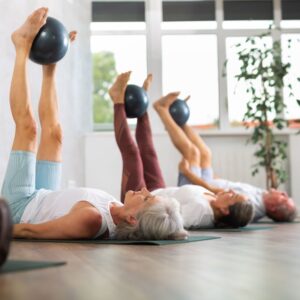
• Physical Health: Exercise strengthens muscles and bones, reducing the risk of falls and injuries. It also improves heart health, lowers the risk of chronic diseases like diabetes, and helps manage weight.
• Mental Well-being: Physical activity can boost mood, reduce symptoms of depression and anxiety, and even improve cognitive function.
Overall, staying active helps seniors stay independent, improves their quality of life, and allows them to enjoy their golden years to the fullest.
What are some other benefits of dancing like you’re not aging?
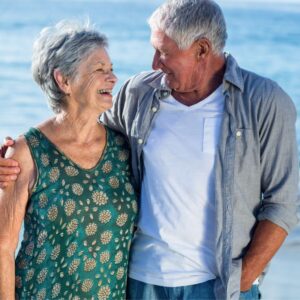 Improving Strength, Flexibility, and Agility
Improving Strength, Flexibility, and Agility
As we age, maintaining muscle strength and flexibility becomes crucial. Dancing helps achieve this by engaging various muscle groups and promoting better overall physical fitness.
Enhancing Mental Sharpness
Dancing stimulates the mind through learning choreography, rhythm, and coordination. It’s like a workout for your brain! Plus, the joy of dancing can lift your spirits and keep your mind active.
Preventing Falls
Balance is essential for seniors, especially since falls are a common concern. Dancing improves balance and coordination, reducing the risk of falls. Strengthening core muscles also supports better posture.
Boosting Emotional Well-Being
Dancing can chase away the blues! The social aspect of dancing, along with the sheer enjoyment of moving to music, contributes to emotional health.
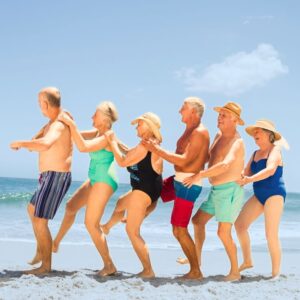
Social Connection
Dancing provides opportunities for social interaction. Whether you’re dancing with a partner, in a group class, or at a community event, it fosters connections and combats loneliness.
Easing Chronic Pain
Engaging in dance can alleviate chronic pain. The rhythmic movements and endorphin release contribute to pain relief.
On the flip side, not being active can have significant negative effects on seniors’ health and well-being.
Some of the negative consequences of being inactive:
Weight Gain and Obesity: A sedentary lifestyle increases the risk of weight gain. Inactive seniors are more likely to struggle with obesity, which can lead to various health issues.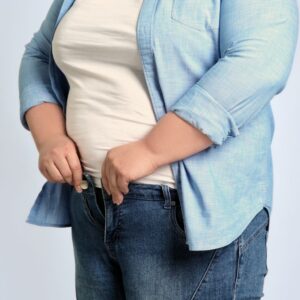
Heart Diseases: Seniors who remain inactive are at greater risk of heart disease. Lack of regular exercise contributes to a higher incidence of coronary artery disease, heart attacks, and other cardiovascular problems.
High Blood Pressure: Seniors who don’t engage in regular exercise may experience hypertension, as physical inactivity is associated with elevated blood pressure levels.
Stroke: Sedentary behavior raises the likelihood of stroke.
Metabolic Syndrome: Being inactive contributes to the development of metabolic syndrome, which includes high blood pressure, high blood sugar, excess abdominal fat, and abnormal cholesterol levels.
Type 2 Diabetes: Not being active makes seniors more prone to developing type 2 diabetes.
Certain Cancers: Breast, colon, and uterine cancers are all associated with a sedentary lifestyle.
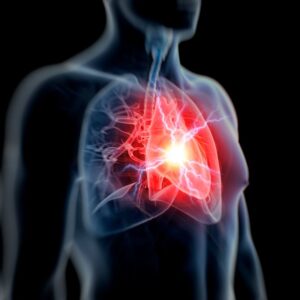
Reduced Mobility and Disability: Losing mobility due to inactivity often means seniors are less likely to maintain their independence and may experience a poorer quality of life, higher rates of disease, and hospitalization.
Emotional Well-Being: It makes sense that, if physical exercise contributes to our emotional well-being, the lack of it would do the opposite. And it does – inactivity can contribute to feelings of anxiety and depression.
Premature Death: The less active a senior is, the higher their health risks, including premature death.
Dance like I’m not aging… but how?
Seniors can explore various types of dances, each offering unique benefits. Here are some dance styles that are particularly well-suited for older adults:
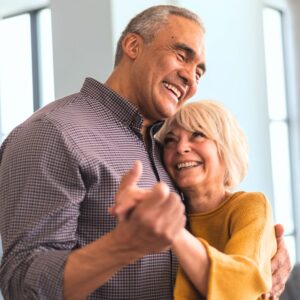
Ballroom Dancing
Waltz, foxtrot, tango, and swing are popular ballroom dances.
Benefits:
• Social Interaction: Ballroom dancing often involves partnering, making it a great way to connect with others.
• Balance and Coordination: The structured movements enhance balance and coordination.
• Mental Stimulation: Learning choreography keeps the mind active.
Line Dancing
Line dances are performed in rows or lines without a partner.
Benefits:
• Cardiovascular Fitness: Line dancing provides a good cardiovascular workout.
• Memory Enhancement: Remembering sequences improves cognitive function.
• Community: Seniors can join line dance classes for a sense of community.
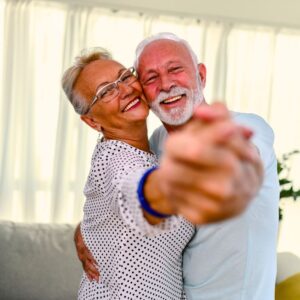
Swing Dancing
Lindy hop, East Coast swing, and jitterbug fall under swing dance.
Benefits:
• Cardio Exercise: Swing dancing involves energetic movements.
• Joint Mobility: The rhythmic swings promote joint flexibility.
• Fun and Socializing: Seniors can enjoy dancing with partners.
Square Dancing
Square dancing is performed in groups of four couples.
Benefits:
• Physical Activity: It’s a moderate-intensity aerobic exercise.
• Memory and Mental Agility: Following calls engages the brain.
• Social Bonding: Seniors can participate in square dance clubs.
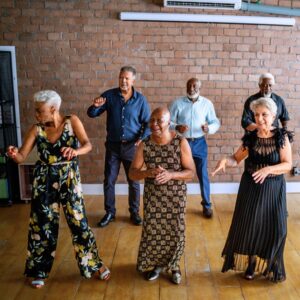
Folk and Cultural Dances:
Explore traditional dances from different cultures.
Benefits:
• Preserving Heritage: Seniors can connect with their cultural roots.
• Physical Fitness: Folk dances often involve rhythmic steps.
• Emotional Well-Being: Dancing to familiar tunes evokes positive emotions.
Zumba
Zumba combines dance and fitness moves.
Benefits:
• Cardio Workout: Zumba classes are energetic and fun.
• Stress Relief: Dancing to lively music lifts spirits.
• Adaptability: Zumba can be modified to suit different fitness levels.
Ballet and Barre
Modified ballet movements are excellent for seniors.
Benefits:
• Strength and Posture: Ballet exercises improve muscle tone.
• Graceful Movements: Seniors can enjoy the elegance of ballet.
• Mind-Body Connection: Focusing on form enhances mindfulness.
Remember that the best dance style varies based on individual preferences, fitness level, and any existing health conditions. Choose dances you enjoy and feel comfortable with. Whether it’s a formal ballroom or a casual dance class, moving to music brings joy and health benefits!
Dive even deeper into this topic with the National Institute on Aging by clicking here.
Learn how PPMA can help you achieve your health goals.

